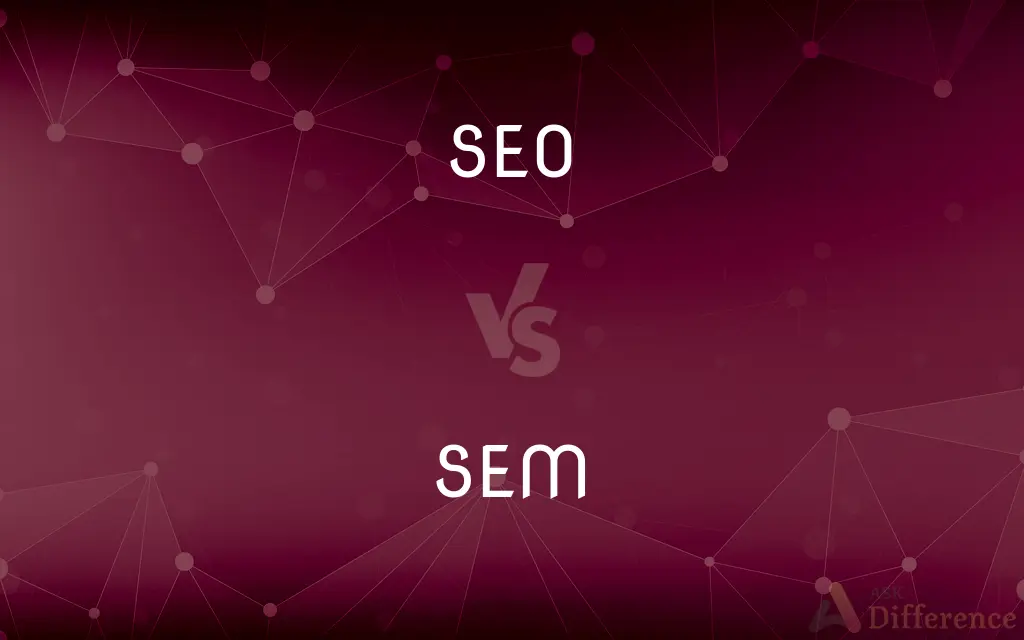SEO vs. SEM — What's the Difference?
By Tayyaba Rehman — Published on January 11, 2024
SEO (Search Engine Optimization) improves organic search rankings; SEM (Search Engine Marketing) encompasses SEO and paid search strategies.

Difference Between SEO and SEM
Table of Contents
ADVERTISEMENT
Key Differences
SEO (Search Engine Optimization) focuses on optimizing a website to rank higher in search engine results organically. SEM (Search Engine Marketing) includes SEO tactics and also involves paid advertising strategies like PPC (pay-per-click) to increase visibility.
SEO is about enhancing a website’s content, structure, and on-page elements like keywords, metadata, and site speed for better organic ranking. SEM not only uses SEO principles but also involves paid advertising campaigns, such as Google AdWords, to gain traffic.
SEO is a component of SEM; while SEO aims for long-term organic traffic growth, SEM seeks immediate visibility in search engines through paid and organic strategies.
SEO requires time to build up and see significant results as it depends on organically growing a site’s presence. In contrast, SEM can offer instant results through paid ads, which appear at the top of search engine results.
SEO is cost-effective in the long run as it builds organic search credibility. SEM, while potentially offering quicker results, requires ongoing investment in paid advertising for visibility.
ADVERTISEMENT
Comparison Chart
Includes
Organic search optimization
Both organic and paid search strategies
Goal
Improve organic search ranking
Increase overall visibility in search engines
Timeframe for Results
Long-term
Can be immediate with paid ads
Cost
Lower over time; no direct payment for clicks
Includes cost for clicks in paid campaigns
Strategy Focus
On-page and off-page optimization
Combination of SEO tactics and paid advertising
Compare with Definitions
SEO
Improving a website to rank higher in search engines.
By optimizing keywords, the website’s SEO improved, leading to higher organic traffic.
SEM
Combines SEO with paid advertising.
Our SEM plan includes PPC campaigns along with organic SEO tactics.
SEO
Involves on-page and off-page strategies.
Through effective SEO, the blog’s backlink profile significantly improved.
SEM
Targets specific audiences through ads.
SEM helped us target a niche audience effectively with tailored ads.
SEO
Aims to increase organic traffic.
Effective SEO led to a 50% increase in organic search traffic.
SEM
Aims for immediate visibility in search results.
Using SEM, the new product appeared at the top of search results on day one.
SEO
Enhances website usability and performance.
Improving site speed was a key SEO tactic to reduce bounce rates.
SEM
Involves managing ad campaigns and bids.
Our SEM strategy focuses heavily on optimizing our AdWords bids.
SEO
Focuses on content relevance and quality.
Updating old content is a crucial part of our SEO strategy to remain relevant.
SEM
Tracks ROI from paid search ads.
The SEM report showed a positive ROI from our latest PPC campaign.
Common Curiosities
What does SEM include?
SEM includes both SEO efforts and paid advertising strategies.
What is SEO?
SEO involves optimizing a website to rank higher in organic search results.
How does SEO improve a website?
SEO improves a website’s content, structure, and relevance to search queries.
Is content important in SEO?
Yes, quality and relevant content are key components of SEO.
Is SEM more expensive than SEO?
SEM can be more expensive due to the inclusion of paid advertising costs.
Does SEO require technical knowledge?
Yes, SEO often requires understanding website coding and structure.
Can SEM target specific demographics?
Yes, SEM can target specific demographics through tailored ads.
Can SEO results be seen immediately?
No, SEO typically takes time to show significant results.
Are SEM results quicker than SEO?
Yes, SEM, especially through paid ads, can provide quicker results.
Is user experience important in SEO?
Yes, good user experience is crucial for effective SEO.
Why is SEM used?
SEM is used for immediate visibility and targeted traffic through paid ads.
Do SEO strategies change often?
Yes, SEO strategies evolve with search engine algorithms and user behavior.
How does SEM affect brand visibility?
SEM enhances brand visibility through both organic and paid search results.
Can you track ROI in SEM?
Yes, SEM allows for detailed tracking and analysis of ROI.
Is link building part of SEO?
Yes, link building is an important off-page SEO tactic.
Share Your Discovery

Previous Comparison
RAID 1 vs. RAID 5
Next Comparison
Digital Marketing vs. Network MarketingAuthor Spotlight
Written by
Tayyaba RehmanTayyaba Rehman is a distinguished writer, currently serving as a primary contributor to askdifference.com. As a researcher in semantics and etymology, Tayyaba's passion for the complexity of languages and their distinctions has found a perfect home on the platform. Tayyaba delves into the intricacies of language, distinguishing between commonly confused words and phrases, thereby providing clarity for readers worldwide.












































